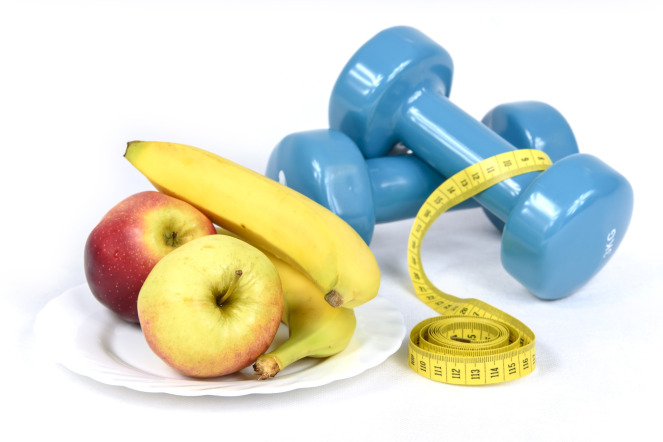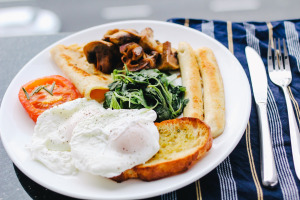The moment we see a friend or a relative who seems to have put on weight, this is what we tend to very promptly tell the person (or perhaps imagine ourselves telling the person):
- You need to move your ass. Stop being lazy!
- You need to hit the gym or do some yoga.
We assume that the person “getting fat” is just plain lazy, keeps sitting around the whole day, and does not exercise at all. “Probably he/she should at least go for a walk!” is what we think. Or if the person has been engaging in physical activities, we think “Umm, maybe he/she needs to push harder.”
The end result is the same if we flip the above situation on ourselves; the moment we realize we’ve put on a few extra pounds, we get that gym membership we had been for so long putting off or we head out on frantic morning runs.

**********
Weight management has two parts: what we consume and what we expend. We tend to focus so much on what we expend — because of course, we can see the sweat and feel the workout pain — that we reduce our focus on what we are feeding our bodies. We feel that the exercise will take care of whatever we eat. Or we eat slightly more to (over) compensate for our calorie loss during the exercise.
I had read about the 80/20 rule sometime over the last year and I have come to strongly believe in it after following it myself and seeing results . As per this rule, weight loss is ** _ 80% d iet and 20% exercise_**. It means that when it comes to losing weight, exercise is a very tiny component as compared to what we eat. We need to shift the focus from sweating it out to what we are putting into your bodies to lose pounds and inches. And the next time we see someone overweight, realize that the magic lies on his plate, not in the gym. In this post, I am going to delve into this rule a bit more and present my take on how to dedicate 80% of our time and attention to what we eat.
(If you search the Internet, you will come across other interpretations of the 80/20 rule. One of the 80/20 diets out there is to eat healthy 80% of the time and indulge in cravings for the rest 20%. Another one derives from the Pareto’s Principle, stating that we can get 80% successful weight loss results with 20% change in our diet.)
The WHY
First let me answer “why” the 80% focus on what we eat. You can do this experiment if you wish (I have), but if you do not exercise for a period and just intake “healthy food”, your body will shrink, change its composition, let go of the stored fat, change its fuel source, and you will feel differently.
It takes a lot of time and effort to worry about and pay attention to what you are eating, all the time, the whole day, day after day. After doing it for long enough, you do get into the groove of how much of what to eat (and what to completely avoid). But the importance of eating right does not diminish.

The importance of exercising comes from the benefits it offers — keeps you fit, toned, and mentally active and charged. You do need to put in time to perform specific workouts, both cardio AND strength. Strength training ensures that you do not lose your lean muscles and it’s actually the fat you burn by building muscles, apart from stimulating post-workout calorie burn and better metabolism. Cardio keeps your heart active and you burn more calories during the workout session.
Undisputedly, exercise is an important component for losing weight, albeit a very small component when compared to your diet. You cannot rely solely on what you are expending in the gym or out on a run to lose weight, simply because:
a) There are times when you cannot workout or have to skip a session because you are recovering from a previous workout.
b) You don’t exercise at the same intensity everyday.
But you ALWAYS have to eat. And every time you eat, the responsibility of eating right is always on your shoulders. That’s why the 80/20 rule emphasizes to pay more attention to what you eat and get that right each time.
To quote from Nerdfitness.com:
Not only are you wasting time by putting your focus on all the other stuff, but no matter how much you exercise, you cannot out-train a bad diet. In fact, exercising is a tiny fraction of how our bodies burn calories in comparison to just existing.
– [nerdfitness.com](https://www.nerdfitness.com/blog/2015/03/09/why-exercise-is-the- least-important-part-of-the-equation-and-a-camp-nerd-fitness-update/)
and
We understand that 80% of our success in losing weight will be a direct results of what we eat.
The HOW
Coming to how to spend 80% of our focus on food. The first part deals with how to start looking at food in terms of its constituents. There are a lot of school of thoughts out there from which to choose a diet that clicks with you. There’s Atkins, Mediterranean, South Beach, Low carb high fat (LCHF), Low carb high protein, Whole30, Ketogenic, Paleo, BalancedHabits, and probably many more. Before you try to follow any of these, you most definitely need to:
- Get familiar with the macronutrients (macros) in food — carbohydrates, proteins, and fat
- Get familiar with the glycemic index/insulin phenomenon (explained at length in the Always Hungry book)
- Get familiar with the different types of fats — saturated, monounsaturated, polyunsaturated, trans fats
- Understand the impact of each of these macros on our bodies
- Learn and make it a practice to read “Nutrition Info” and “Ingredients” on food labels
- Remember that diet IS NOT starvation

A ‘full’ English breakfast
Most of the diets differ in the ratios of carbs, proteins, and fats they advocate to consume. You need to invest the time to see the effect of eating food with different ratios of these macros on your body. Then, adopt one and stick to that eating lifestyle. Choose something that is sustainable in the long run. Then when you are either cooking at home or eating out or traveling, you always pay attention to and follow that ratio of macros. You keep doing that until your body gets used to it and even after.
It might be false to assume that everything cooked at home is healthy and good for you. Drinking fruit juices or eating salads and fruits might seem like a healthy option to lose weight, but you just might be consuming a lot of carbs, in turn, spiking your blood insulin. You will need to balance the fruits and salads with foods containing appropriate amounts of proteins and fats. Whether its home-cooked food or some healthy option you eat outside, you need to break it all down in your head and know how much carbs, proteins, and fat you’re consuming. You always need to be wary of the ingredients and their macronutrient makeup. With this knowledge, you can add other items to a meal to make it balanced in all macros or specifically increase a macro.
The second part of the 80% diet focus involves breaking free from previous eating habits and cultural food attachments. I know, easier said than done. From the previous part that talked about getting familiar with the macros, you will become more aware of the composition of food that you are traditionally in the habit of eating. You will realize how some of those “feel-good”, “comfort”, and “staple” foods have alarmingly high ratio of one or more macros and probably are a big factor in slowing your weight loss.
Letting go of these cultural food attachments is more of a mental fight. Again, speaking from personal experience, it is a mindset that you cannot stop eating fluffed Indian bread (roti), fried Indian bread (paratha), rice, baked breads, tortillas, beans, pastas, chips, hotdogs, burgers, pizza, or popcorn. It is possible to stop obsessing about foods that you have been eating for years by swapping them with other satiating and nutritious options. Trust me, it’s all for the greater good ;-). Like with anything else in life, breaking your ties with habitual foods will liberate you.
In adopting a diet, if you are unable to make a drastic switch to completely new foods, begin by making small changes. All it needs is inverting (reducing) the ratios of what you have been eating for years and introducing other kinds of food (perhaps more non-starchy vegetables or more fats [in case of keto or LCHF]). This is perhaps the most important change required for a healthy eating lifestyle. You need to make ‘some changes’ in the foods you eat to see ‘different results’. “You cannot keep eating the way you’ve eaten your whole life and expect different results” — is what I regularly told myself in my weight loss journey and to break free from foods I loved (and still love; but I also want results). You cannot arrive at the desired results “only” by exercising.
Food for thought: We say “No pain, no gain”, but we always equate “pain” with the physical pain we endure after a workout. We take pleasure in this pain and dream of the sweet results that the workout will bring us. We never equate “pain” with the pain of letting go of some foods we love and crave, which are, say high in carbs or high in proteins. We never equate “pain” with non-indulgence. We are more willing to inflict physical pain on our bodies (working out) than to inflict any pain on our taste buds.
The third part of spending the 80% focus on what we eat is to cook your meals and to rarely eat out. You need to invest the time in looking for the right recipes for whatever diet you’ve chosen, charting your weekly menus, and spending the time in the kitchen. There is no hack around it. The only hack is to cook for more than one meal at a time.
I’m not even going to talk about the 20% focus on workout. You can take up whatever activity you like. The only most important thing to remember is to not keep it all cardio.
In Conclusion
When you know you’re killing yourself at the workouts and still not seeing any change in weight or the change is not commensurate with the effort you’re putting in, you know its time to play with some other factor. You don’t always have to go on a guilt trip if you miss a week of exercising. What you eat will take care of you.
It’s all about what you eat! I promise you that the 20% time and effort that you spend on workouts will show real results if you turn 80% of your attention to what you eat day in and day out. People are not overweight just because they are not working out. A very large part is due to their food choices.
References
To drive home the point, here are some great additional reads:
- Antranik.org: Understanding Why Abs are Made in the Gym But Revealed in the Kitchen
- Nerdfitness.com: How to Lose Weight Without Doing One Minute of Exercise
- BalancedHabits: They are nutrition consultants who believe in the 80/20 principle and advocate balanced macronutrients per meal
- MyNetDiary.com: The New 80/20 Rule
- Elle.com: Is Focusing on Exercise Sabotaging Your Weight Loss?